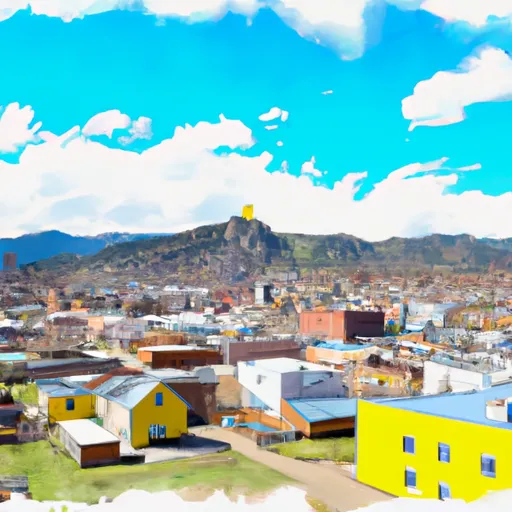-
 Snoflo Premium
Snoflo Premium
Get unlimited access to all our content
With no Ad interruptions! - Start Your Free Trial Login with existing account
Mosca
Eden Index
Climate
6.5
•
Recreation
6.3
•
Community
•
Safeguard
4.8/10

Mosca, Colorado is a small unincorporated community located in Alamosa County. Situated in the San Luis Valley, it experiences a semi-arid climate characterized by cool winters and warm summers. Average temperatures range from the mid-20s °F in winter to the mid-80s °F in summer. Precipitation is relatively low throughout the year, with an annual average of around 7 inches, primarily occurring in the form of snow during winter months.
Hydrology in Mosca is primarily influenced by the nearby Rio Grande River and its tributaries. These water sources provide vital irrigation for the region's agricultural activities, including the cultivation of crops such as barley, potatoes, and alfalfa. The area is also famous for its vast sand dunes formed by wind-blown sand from the river's floodplain.
Outdoor enthusiasts visiting Mosca have various recreation opportunities to explore. The nearby Great Sand Dunes National Park and Preserve offers a unique experience of hiking on the tallest sand dunes in North America. Visitors can also enjoy sandboarding, camping, and wildlife watching in the park. Additionally, the Rio Grande National Forest, located to the west, provides opportunities for hiking, fishing, hunting, and camping in a picturesque mountainous setting.
What is the Eden Index?
The Snoflo Eden Index serves as a comprehensive rating system for regions, evaluating their desirability through a holistic assessment of climate health, outdoor recreation opportunities, and natural disaster risk, acknowledging the profound impact of these factors on livability and well-being.
Climate Health Indicator (CHI): 6.5
Mosca receives approximately
195mm of rain per year,
with humidity levels near 69%
and air temperatures averaging around
6°C.
Mosca has a plant hardyness factor of
5, meaning
plants and agriculture in this region thrive during a short period during spring and early summer. Most
plants will die off during the colder winter months.
By considering the ideal temperature range, reliable water supplies, clean air, and stable seasonal rain or snowpacks, the Climate Health Indicator (CHI) underscores the significance of a healthy climate as the foundation for quality living.
A healthy climate is paramount for ensuring a high quality of life and livability in a region, fostering both physical well-being and environmental harmony. This can be characterized by ideal temperatures, reliable access to water supplies, clean air, and consistent seasonal rain or snowpacks.
Weather Forecast
Streamflow Conditions
Rio Grande Headwaters
Area Rivers
Rio Grande Headwaters
Snowpack Depths
Rio Grande Headwaters
Reservoir Storage Capacity
Rio Grande Headwaters
Groundwater Levels
Recreational Opportunity Index (ROI): 6.3
The Recreational Opportunity Index (ROI) recognizes the value of outdoor recreational options, such as parks, hiking trails, camping sites, and fishing spots, while acknowledging that climate plays a pivotal role in ensuring the comfort and consistency of these experiences.
Access to outdoor recreational opportunities, encompassing activities such as parks, hiking, camping, and fishing, is crucial for overall well-being, and the climate plays a pivotal role in enabling and enhancing these experiences, ensuring that individuals can engage in nature-based activities comfortably and consistently.
Camping Areas
| Campground | Campsites | Reservations | Toilets | Showers | Elevation |
|---|---|---|---|---|---|
| San Luis State Park | 51 | 7,511 ft | |||
| Coaldale | 10 | 7,340 ft | |||
| Alvarado | 50 | 8,962 ft | |||
| Lake Creek | 11 | 8,262 ft | |||
| Hayden Creek | 11 | 7,758 ft | |||
| North Crestone Creek | 13 | 8,474 ft |
Nearby Ski Areas
Catastrophe Safeguard Index (CSI):
The Catastrophe Safeguard Index (CSI) recognizes that natural disaster risk, encompassing floods, fires, hurricanes, and tornadoes, can drastically affect safety and the overall appeal of an area.
The level of natural disaster risk in a region significantly affects safety and the overall livability, with climate change amplifying these risks by potentially increasing the frequency and intensity of events like floods, fires, hurricanes, and tornadoes, thereby posing substantial challenges to community resilience and well-being.
Community Resilience Indicator (CRI):
The Community Resilience Indicator (CRI) recognizes that education, healthcare, and socioeconomics are crucial to the well-being of a region. The CRI acknowledges the profound impact of these elements on residents' overall quality of life. By evaluating educational resources, healthcare accessibility, and economic inclusivity, the index captures the essential aspects that contribute to a thriving community, fostering resident satisfaction, equity, and social cohesion.

